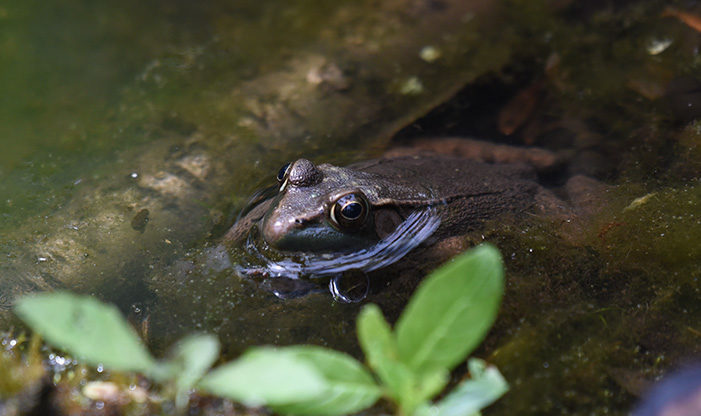Many people enjoy observing frogs and toads at Schlitz Audubon during the warmer months. These charismatic amphibians can be seen basking in the sun, catching insects, and even swimming as tadpoles. They also make their presence known during the breeding season when males produce calls to attract females and defend territories. Of the 12 species of frogs and toads in Wisconsin, nine have been documented at the Center over the years, and six frog species at Schlitz Audubon can frequently be observed in summer.
True Frogs
The wood frog (Lithobates sylvaticus) prefers moist forest habitat and breeds in ephemeral ponds. They can be identified as small brown frogs with a dark “mask” behind the eye and a white upper lip. Their call sounds like a hoarse, subtle quacking which you can occasionally hear in the Woodland Loop between late March and early May. The range of the wood frog extends farther north than any other amphibian in North America, above the Arctic Circle in Alaska. They have evolved an amazing adaptation to survive freezing temperatures by producing a natural “antifreeze” which keeps ice from forming in their cells.
Green frogs (Lithobates clamitans) and bullfrogs (Lithobates catesbeiana) are the largest frogs at the Center and inhabit many of the deeper bodies of water, like Mystery Lake and Wood Duck Pond. These are the frog species at Schlitz Audubon many people think of as “typical frogs,” with green to brownish-green bodies and long legs. These species can appear similar, but bullfrogs will reach a larger adult size (up to eight inches long!) and do not have a dorsolateral ridge (a fold of skin extending from the eye to the lower back) like green frogs. The tadpoles of both species overwinter at the bottom of permanent water bodies, with bullfrogs preferring a habitat containing more abundant vegetation.
Treefrogs
Spring peepers (Pseudacris crucifer) are tiny tan-colored treefrogs, with a dark irregular shaped “X” marking their backs. A common species at the Center, they are more often heard than seen. Males produce a high-pitched “peep” call by inflating the vocal sac in their throat like a balloon. Some people compare the sound to “jingle bells” and when a chorus of males call at the same time, the sound can be unbelievably loud. Teal pond is a good place to listen for spring peepers in April and May.
Gray treefrogs (Hyla versicolor) have the amazing ability to change their skin color from gray to green, depending on temperature and the color of their surroundings. They can be found in most areas at the Center because they prefer wetland habitats adjacent to woodlands. Adult gray treefrogs are slightly larger than spring peepers, reaching a length of up to 2.4 inches, whereas spring peepers have a maximum size of 1.5 inches. Both species have sticky toe pads, which enable them the climb trees and shrubs.
Toads
Wisconsin’s only toad species, the American toad (Anaxyrus americanus) can often be found walking or hopping on the Center’s trails in spring and summer. This terrestrial species can live in a variety of habitats, such as woodlands, prairies, wetlands, parks, and suburban yards. Toads have stocky bodies with short legs, warty skin, and special parotoid glands behind their eyes which release chemicals that aid in defense against predators. Toads feed on a variety of invertebrates like insects, spiders, snails, and earthworms. During the breeding season, they move to a body of water to mate and lay eggs. The male’s call is a long uninterrupted trill lasting up to 30 seconds. You may be able to see the toad’s tiny black tadpoles swimming in Mystery Lake in late spring or early summer.
Conservation
Amphibians are considered a biological indicator of the health of the environment. Their permeable skin makes them sensitive to a variety of environmental changes such as pollution, disease, and habitat degradation. Worldwide, amphibian populations have been declining since the 1970s, so conservation efforts, especially in wetland habitats, are crucial to the future survival of frogs and toads.
The Center is working towards amphibian conservation through our Stormwater Wetland and Ravine Restoration Project, which over the last two years has allowed us to increase our wetland habitat. The expanded wetlands created by the berm that runs along the wooded North Ravine are ideal for tree frogs and spring peepers. We also have two new ponds, which are the perfect habitat for the deep-water species. To further assist our conservation efforts, we monitor frogs to learn how they colonize these new areas. Overall, these efforts improve habitat for amphibians and other wildlife at the Center.


